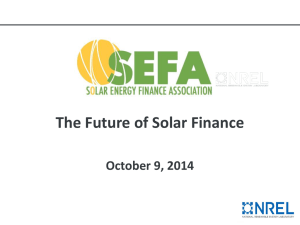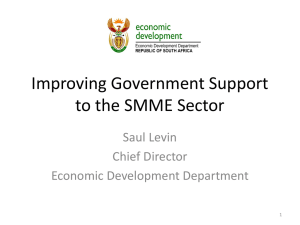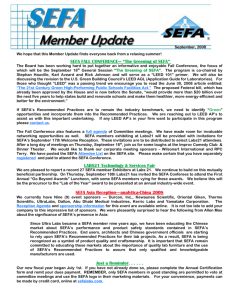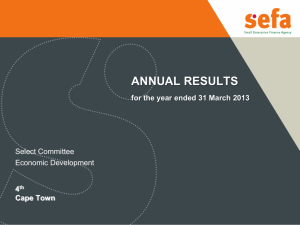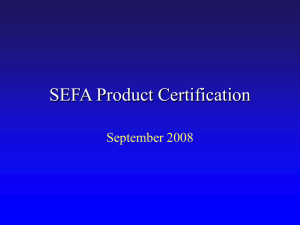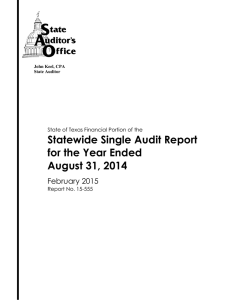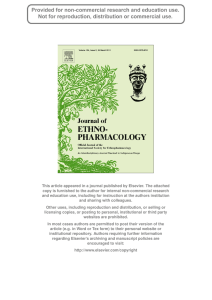Susanna Hennesy Lavery CPHAN 031308
advertisement
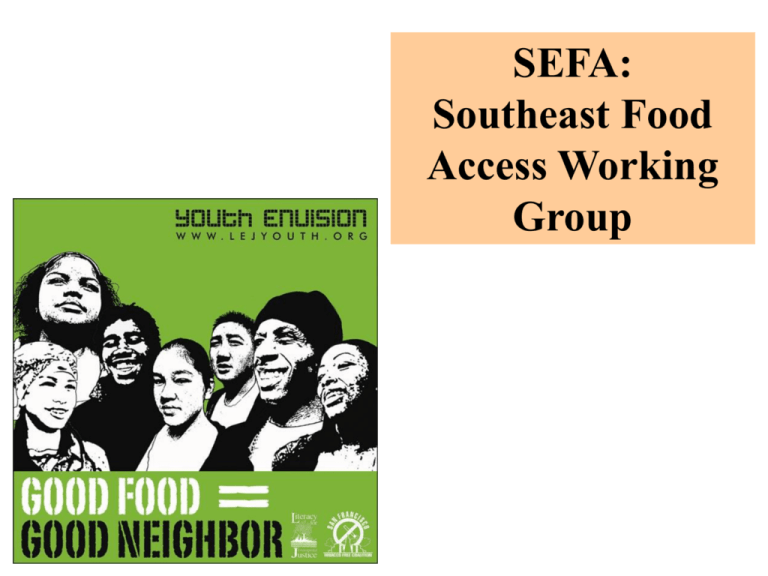
SEFA: Southeast Food Access Working Group Food Deserts… The causes of food insecurity include supermarket flight from inner cities, transportation barriers, inundating inner cities with fast food chains and food that is high in salt, sugar, and fat. Food insecurity contributes to growing rates of diabetes and obesity – health concerns that rank high in inner city communities like Bayview. Bolen, E. and Hecht, K. (2003, January). Neighborhood Groceries: New Access to Healthy Food in Low Income Communities. California Food Policy Advocates. Food Insecurity in the U.S. 1. 1/6 are food insecure in US 2. Low Income people and people of color are more likely to suffer from food insecurity (hunger and obesity). 3. Food insecurity affects 35% of low income households in the US 4. African American and Latino households face food insecurity and hunger rates three times as high as those of white households. (USDA) CAM - Step 2 Define,Design and Do Community Diagnosis CPBR Brown = packaged foods Yellow = alcohol and cig.s Blue = all other beverages Purple = meat Green = produce Red = non-food products CAM - Step 3: Analyze the Diagnosis 11 Store Diagrams Total Result Products Sold in 11 Corner Stores in BVHP Produ ce 2% • • • • • • 39% Packaged Foods 26% Alcohol & Cigarettes 17% All Other Beverages 13% Non-Food Products 3% Meat 2-5% Produce Meat 3% Non-Fo od Pro ducts 13% Packag ed Foods 39% All oth er Bevera ges 17% Alcoho l & Cig arettes 26% CAM - Step Three: Analyze CPBR (Diagnosis) After performing our own surveys and diagrams of 11 corner stores on 3rd Street, we found that most readily available products in BVHP are alcohol, tobacco and junk foods. (from PPT: LEJ 2004) How It Works! What the Retailer Has to do to Qualify as GN. Stock Fresh Produce A minimum of 10% of items in the establishment must be fresh produce, diverse (6 varieties)…encouraged to stock culturally appropriate, organic & locally grown. Stock Healthy Foods A minimum of 10% of items must be healthy foods (for example not K/N) Participate in programs making Food Accessible and Affordable, Food Stamps, WIC? Limit Tobacco & Alcohol Advertising and Promotion & Sales remove all outdoor ads and ads indoor near children (3 feet) Adhere to all Laws regarding Illegal Transactions… Adhere to Environmental Standards and all existing policies and codes addressing loitering, cleanliness and safety. How It Works! What is in it for you? GN incentives As a participating “Good Neighbor” establishment you may be eligible for anyone – or all – of the following free incentives: Energy efficient lighting, refrigeration, or appliances for your business In store promotional programs Advertising in the Bayview Newspaper Branding as a “Good Neighbor Store” for your windows and doors Training in produce handling and store display Other incentives offered by city agencies such as storefront façade improvement, products, rebates, etc Improving food access for residents and workers who want healthy food offered in BVHP community The Partnership LEJ (Literacy for Environmental Justice), Rainbow Food Coop, SF Produce Mart, Veritable Vegetable, Food Runners and … The Good Neighbor Incentive Program MEMORANDUM OF UNDERSTANDING between the Mayor’s Office of Economic Development, the San Francisco Redevelopment Agency, the Department of Public Health, the SF Department of the Environment, March 1, 2005-June 30, 2008 Super Save Pilot Partnership December 19, 2003, LEJ Youth Envision launched the opening of the Good Neighbor partnership with Super Save Grocery! • Produce Sales: up from 1% to 15% • Tobacco/Liquor sales down 10% • Overall Sales up about 12% • Only allows Tobacco ads behind the counter….up high! Surfside Liquor Store Challenges, and Lessons Learned: role of PH Corner Store Conversions are: • part of the solution…. • time and resource intensive… • Community driven, CBPR for policy development, building community relationships. • Community involvement: outreach, taste testing, cooking demo’s… (LEJ Youth) • Have your systems in place Best Practices Kit Program Materials and Systems •Merchant Agreement •Merchant Outreach Brochure •Marketing Materials: GN seal, poster, shopping bags •Assessment and Incentive tracking tools. •Compliance and Certification Plan •GNAC: Good Neighbor Advisory Council SEFA: Southeast Food Access Working Group The goal of SEFA is to work collaboratively across city and community agencies to ensure that healthy, fresh, sustainable, and affordable produce is accessible to all residents of the BVHP, utilizing existing venues and supporting transformation and/or creation of new ones. SEFA Members Co chairs: SEHC director & WPM general manager Community Based Partners CCSF Partners BVHP Farmer’s Market BVHP Foundation CPMC Bayview Child Health Center Hunter’s Point Family Literacy for Environmental Justice Network for Elders Quesada Gardens Initiative Reachout for the Rainbow After School SF Food Bank SF Wholesale Produce Market San Francisco Food Systems Department of the Environment Department of Public Health Department of Public Works Mayor’s Office of Community Development Mayor’s Office of Economic and Workforce Development San Francisco Redevelopment Agency SEFA Activities Looking at spectrum of issues across the food system including… 1. Nutrition education/Awareness Raising 2. Collaborate with cbo’s & urban ag projects, 3. FOCUS: Existing markets and new full service market(s) by… - Engaging key city agencies (MOEWD, SFRA, MOCD, DPH) - Identifying need for a survey to understand desires/needs of community. (Summer 2007) SEFA Survey Results Respondents care about values associated with workers rights and organic foods. SEFA SEFA Survey Survey Most residents buy their food outside of the Results •58% want a co-op market •53% “most important” that foods be free of pesticides and chemicals and be grown by local farmers who treat farm workers fairly. Results neighborhood (grocery sales leakage reached $38 million) Lack of quality/freshness of food and safe pleasant shopping atmosphere were cited as reasons why residents don’t shop at existing stores. While 55% preferred a large grocery store, 45% preferred a couple of smaller stores in different locations. “new” Full Service Market • MOEWD participated in SEFA meetings • SEFA sounding board to MOEWD – – – – Visited/contacted independent stores Advocated to potential stores Recommended Tesco, Fresh and Easy Survey utilized and considered • In December 2007, Fresh and Easy broke ground: full service market in BVHP to open mid 2009. • Met with two existing stores to discuss survey findings and ways to address issues…. Future SEFA Work • Nutrition Education/Awareness Raising (collaborate with culinary institutes, train community cooks, cooking demo’s, cook books, community kitchens….awareness campaigns…etc) • Work with existing/new grocery stores – Share Survey findings: FoodsCo, Supersave – Market Watch • Continue collaboration with SEFA member projects doing urban edible gardening, GN, • Leadership by Community (DOE) Challenges, and Lessons Learned: role of PH Full Service Market New Market: TESCO-Fresh & Easy: a Success !?! • Company values • Alcohol moratorium Existing Markets • Invite them to share their expertise • Leverage… Progress: but not a complete solution! Challenges, and Lessons Learned: role of PH • LISTEN to community – Formed SEFA – Survey – Alcohol Moratorium • ACT with community – Provide TA/Leadership • SHARE – Work (Survey, staffing) – Success/failures •CBPR •Policy Development, •Change norms… •Build community… Challenges, and Lessons Learned: role of PH A comprehensive approach is needed… A healthy & sustainable neighborhood food system includes…. •Full service markets •Corner/smaller stores with healthy, fresh, sustainable foods – WIC, Food stamps… •Farmer’s markets •Urban agriculture projects (community gardens etc) •Pantries providing healthy foods •Promotion of healthy eating: (cooking demo’s, awareness campaigns: sustainable food systems, community kitchens) and much, much more! The End
